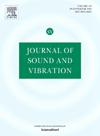Self-sensing sliding mode control of workpiece chatter based on accurate prediction of machining vibration
IF 4.3
2区 工程技术
Q1 ACOUSTICS
引用次数: 0
Abstract
The previous works concerning active chatter suppression in milling systems are generally carried out based on specially designed tool holders or spindles. Due to the continuous removal of materials, however, the workpiece system cannot be treated as quasi-static or rigid. In this paper, a manufacturing system based on the digital twins (DT) model and sliding mode (SM) controller is developed to suppress the milling chatter of thin-walled workpieces. A single degree of freedom (DOF) model of the workpiece is adopted to describe the milling system. The developed SM algorithm exhibits a good performance under the variations of modal parameters, cutting parameters, unmodeled dynamics, etc. To provide accurate control feedback, a DT model of workpiece vibration is established by presenting a self-sensing predictive method. The predictive methods are implemented based on the cooperation of the combination methods of beam functions (CMOBF) and the mode superposition method (MSM). In addition, the predictive accuracy is discussed quantitatively by establishing a dataset of error coefficients. The data of error coefficients are trained by the support vector machine (SVM) model, which is introduced to the predictive methods for further error modification. Finally, a DT framework is introduced briefly to combine the machining system and the control process. Based on the developed DT-driven manufacturing system, the information interaction between the control process and the vibrating system can be realized.
求助全文
约1分钟内获得全文
求助全文
来源期刊

Journal of Sound and Vibration
工程技术-工程:机械
CiteScore
9.10
自引率
10.60%
发文量
551
审稿时长
69 days
期刊介绍:
The Journal of Sound and Vibration (JSV) is an independent journal devoted to the prompt publication of original papers, both theoretical and experimental, that provide new information on any aspect of sound or vibration. There is an emphasis on fundamental work that has potential for practical application.
JSV was founded and operates on the premise that the subject of sound and vibration requires a journal that publishes papers of a high technical standard across the various subdisciplines, thus facilitating awareness of techniques and discoveries in one area that may be applicable in others.
 求助内容:
求助内容: 应助结果提醒方式:
应助结果提醒方式:


